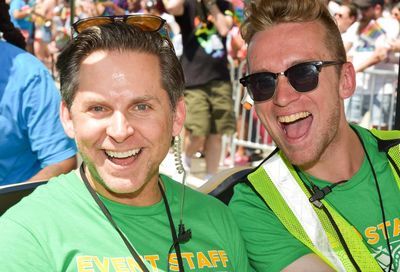Shape Up
Setting Your Fitness Goals and Reaching Them
 |
You remember January 2, don’t you?
That was the day you launched your plan for a whole new year and a whole new you. Right after Christmas you’d joined the gym. You went through your kitchen and dumped all the high-fat and high-carb food in the trash, just like the diet book told you. You planned which days you would go to the gym and what times, so you could plan your work and social dates around it.
Heck, maybe you even bought yourself a journal so you could keep track of your progress: miles logged in cardio, pounds lifted in barbells.
Things looked good. You had a plan. This was going to be the year you made your body happen.
Now it’s February. You’re supposed to hit the gym after work tomorrow, and you think you might actually make it. But that muscle you pulled a couple weeks ago is still nagging at you. And there’s that deadline looming at work, not to mention that party your best friend’s throwing that you simply can’t miss. The gym may have to wait another day.
 |
Or week.
And that carton of Ben & Jerry’s you guiltily bought last night at the corner store and stuck in the freezer is looking mighty good about now.
Lets face it — your New Year’s resolution is in serious trouble. Now’s the time, as the weather gets drearier and your motivation gets harder to maintain, to search for ways to make your resolution more than a one-month stand.
All the things conspiring to keep you from the gym aren’t really anything new, say personal trainers, nutritionists and others whose job it is to help people reach their fitness goals. If this is your first time trying to achieve a more physically fit body and outlook — or even your second or third time — it may come as a bit of a surprise that getting in shape takes a lot more than going to the gym. Even if you hit the weight machines and elliptical trainers every day with a religious fervor, you may find yourself falling far short of the goals you’ve set.
And for those who find themselves lacking the fervor, it’s an even more difficult quandary to solve. But help is out there — according to personal trainers who every year work with people who want to make their resolutions into reality, there are common barriers that keep people from reaching their goals: intimidation, motivation and unrealistic goals.
STAY MOTIVATED
It seems easy to be motivated at first — the whole idea of changing your life feels new and exciting, whether you’re putting together your first workout schedule or making your first trip to the gym. And they should be, because the first steps are an accomplishment.
It’s getting to the second, third, and fourth steps — and beyond — that can be a challenge. There will always be times when life intrudes on your goals and you think, I don’t have the time, I don’t have the energy, I have too much work to do.
 |
And once you lose your motivation, it’s not always easy to get back.
“If there were a motivation pill, everyone would take it,” says Stuart Smith, owner of BodySmith D.C.
Keeping goals in mind is a good way to keep yourself focused when the going begins to get tough.
“They have to go back to the reasons they want this,” says Dale Buchanan, head trainer at Results the Gym in Dupont. “If they want to go to happy hour instead of the gym, they don’t really want it. If every little reason takes them away, they don’t have a strong enough reason to obtain their goal.”
Finding ways to stay motivated is important. Buchanan has clients keep a journal of their efforts — once things are written down, people often find that they’re not putting in as much work as they thought.
Michael Everts, owner of FIT Personal Training Gymnasium, says reaching your goals comes down to the effort you put into it.
“If you expect to work two hours a week and then leave, you’ll see some muscle growth but you won’t meet the goals you set for yourself,” he says. “Those who do the minimum effort don’t achieve as much.”
Understanding how much work is needed to reach the goals you set in your resolution helps keep you motivated, and that motivation can help you be more successful than you may have initially expected.
“Some people change [their bodies], but others go through a metamorphosis where they’re a different person, enjoying life more,” says BodySmith’s Smith.
OVERCOME INTIMIDATION
For someone who’s out-of-shape and looking to change their body, going to the gym can be a paradoxical experience.
“A lot of people who are not used to exercise are usually intimidated by the gym atmosphere,” says Jeffrey Hollebrandt, owner of bodybody Fitness and Health in Virginia. “People feel that they have to look good before they go to the gym.”
 |
Everyone agrees that intimidation on the gym floor is one of the biggest reasons people have trouble following through on their plans to get in shape. And intimidation isn’t just a matter of being surrounded by bodies that are already in shape — it can also be a matter of feeling uncomfortable surrounded by crowds of people.
“Probably half the people [I train] are people who tried working out at the gym and were intimidated,” says Everts. “They like being with someone who can work with them.”
Sometimes finding a workout buddy can help lessen the intimidation factor, but it can be hard to find a partner at the same skill level.
Overcoming the intimidation factor is one of the biggest reasons to look at working with a personal trainer, whether at your gym or at a training center. Working one-on-one or with a group can help you become more comfortable with yourself in a fitness setting.
“There’s no easy way to deal with that,” says Buchanan, who works with gym members in small group personal training sessions. Almost everyone in those groups came into them with some level of intimidation, but after a few weeks that factor had decreased.
So if you’re finding yourself uncomfortable working out with the crowds, remember that you’re not alone. Try scheduling your workout for different hours, outside of the morning and evening rush. And remember, if the gym seems packed right now, the crowds may thin out as the weather warms up.
SET REALISTIC GOALS
Everyone knows that you can’t walk into a gym one morning and walk out the next day looking like a bodybuilder. Yet people still forget that you can’t just walk into a gym, work out for two weeks, and expect five years of sloth to melt magically away from your frame.
Even more than motivation and intimidation, unrealistic goals will set you up for failure before you even get started.
 |
“People set unrealistic goals and they push their bodies too hard,” says Karim Steward, owner of One World Fitness. “When working out is not enjoyable, it’s often because you’re in a state of fatigue. Your nervous system is telling you that it’s just not going to work.”
If you’re just starting a workout routine on your own, you may be tempted to do everything at once in your first week, hitting the cardio machines, weight machines, the barbells and the aerobic classes one right after another. Or maybe you focus on that one pesky body part you want to “fix.”
Resist those temptations.
“Put together a routine that works every part of your body,” says Everts. “Don’t just do cardio. Don’t just try to get big muscles in your upper body. You’ve got to do the un-fun work.”
|
Setting unrealistic goals for yourself can lead to a number of problems that can put an end to your resolution. If you expect lose six inches off your waist in the first three weeks, you’re going to be disappointed.
“People don’t set realistic goals so they get frustration,” says Buchanan. “They think they should be getting something quickly.”
That urge for instant results can also cause people to take on too much, too soon, leading to injuries that will sidetrack even the best-laid plans.
“It’s like having tennis lessons or skiing lessons. You won’t get good at it and have fun until you learn how to do it properly,” says Smith.
Again, the most important thing you can do is find a trainer to help you learn the techniques for a healthy workout, and set goals that are realistic and appropriate for your body.
“The idea is not to slam people,” says Smith. “We start off light, and go by feel and by client. It’s not a contest to show them that I can make them not be able to lift their arms. I want to work with a client within their own limits and what they want.”
It may seem that many of these solutions to common blocks come down to getting yourself a personal trainer, a solution that may seem extravagant. To many, personal training is a luxury for the well-off or the fitness obsessed.
But there are a number of training options. Most gyms offer initial training programs for new members that everyone should immediately take advantage of. Also, you may find that your gym offers on-site training packages for members.
If you’ve been trying to reach your goals for a while, however, and are not having the success you hoped for, then it may be time to consider one-on-one training. Personal training sessions can cost anywhere from $37 to $65 per hour, depending on how many sessions you buy and which center you work with.
“It’s not going to be cheap, but you can afford it if it’s a priority,” says Smith.
“We don’t believe personal training should be hugely expensive,” says Steward. “We’re not looking to make crazy amounts of money. We give you a lot for your dollar.”
The important thing to remember is that looking for a personal trainer to help you out doesn’t have to be a three-times a week commitment. If cost is a big concern for you, consider working with a trainer to develop a program that you can follow at the gym, and then check in with your trainer periodically to chart your progress. The important thing is to learn how to change your body the healthy and safe way.
“If you don’t’ have the basics down, your mistakes will follow you through your movements. You start with the basics and build from there,” says Smith. “If you’re constantly aching or injured, something’s wrong.
So see? If you take a deep breath, celebrate the fact that you’ve made it to February, and set yourself up to maintain your energy, you’ll make it March, then April, then May. And then, to 2005. And beyond.
“It’s not the time of year,” says Steward. “It’s how you apply yourself.”
Support Metro Weekly’s Journalism
These are challenging times for news organizations. And yet it’s crucial we stay active and provide vital resources and information to both our local readers and the world. So won’t you please take a moment and consider supporting Metro Weekly with a membership? For as little as $5 a month, you can help ensure Metro Weekly magazine and MetroWeekly.com remain free, viable resources as we provide the best, most diverse, culturally-resonant LGBTQ coverage in both the D.C. region and around the world. Memberships come with exclusive perks and discounts, your own personal digital delivery of each week’s magazine (and an archive), access to our Member's Lounge when it launches this fall, and exclusive members-only items like Metro Weekly Membership Mugs and Tote Bags! Check out all our membership levels here and please join us today!






























